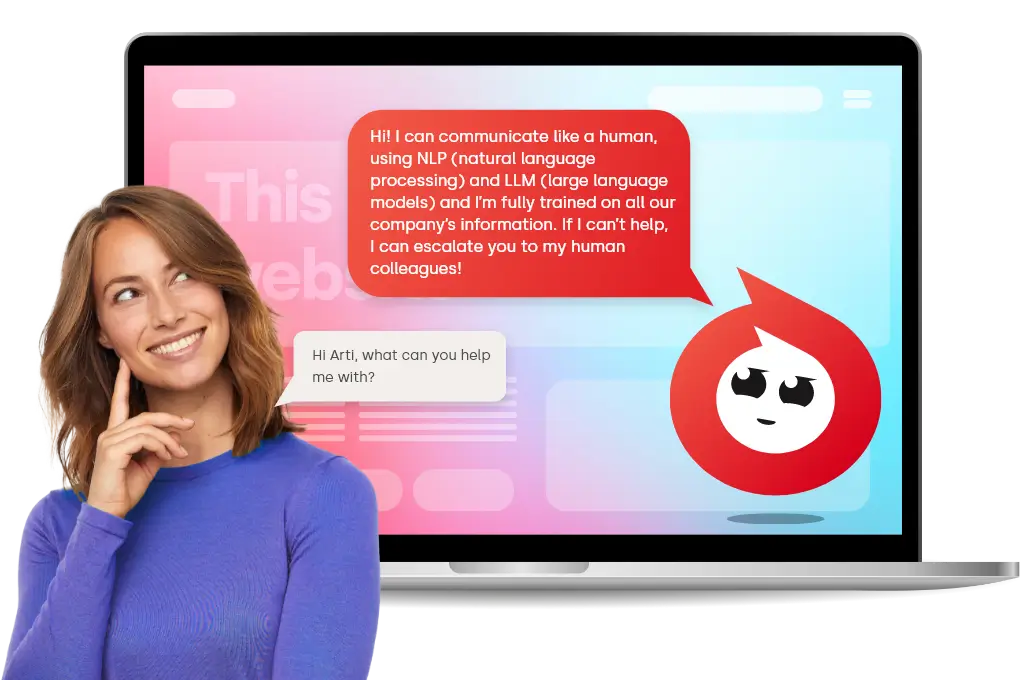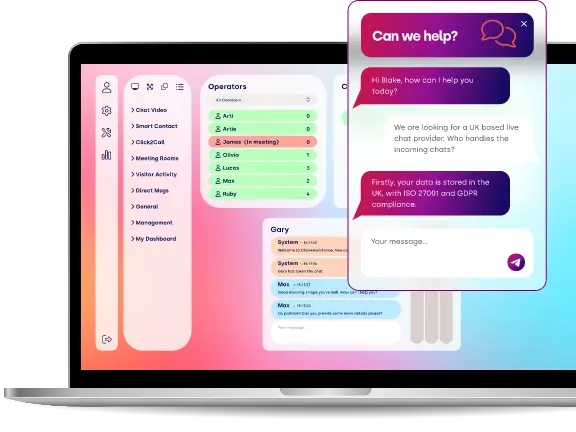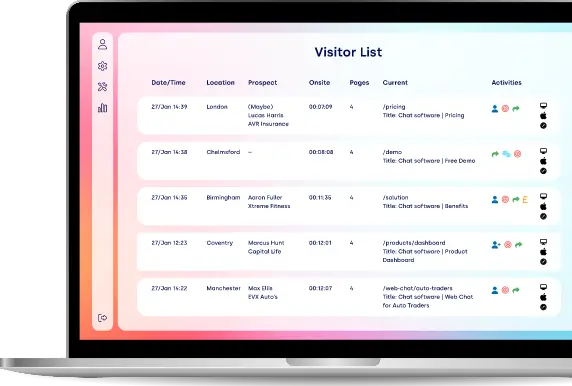AI-Powered Customer Engagement: Transforming the Customer Experience
AI-powered customer engagement personalises interactions, streamlines communication, and enhances customer satisfaction. Helping businesses evolve into smarter and agile organisations.

In today's fast-paced digital world, AI-powered customer engagement is changing the game for how businesses connect with their audiences. By tapping into the latest artificial intelligence technologies, companies can create personalised experiences, improve communication, and boost overall customer satisfaction. Those who adopt AI-powered tools, like conversational chatbots, are seeing impressive improvements in efficiency, engagement, and customer loyalty. Not only do these AI solutions speed up response times, but they also turn customer interactions into a real competitive advantage.
With AI-enhanced customer engagement, businesses gain valuable insights into customer behaviour, allowing them to provide relevant and timely solutions. From automated support to smart product recommendations, AI makes sure customers feel valued and recognised, fostering stronger relationships and increasing retention rates. By integrating AI throughout the customer journey, companies can tackle issues more quickly, anticipate needs, create smooth experiences, and drive sustainable growth.
Understanding AI-Powered Customer Engagement
When we talk about AI-powered customer engagement, it’s so much more than just slapping a chatbot on your website or sending out automated emails. It’s really about taking a strategic approach to how we manage customer relationships using artificial intelligence across different platforms. At its core, it allows businesses to create real-time, contextually relevant interactions that are tailored to what each individual customer wants. Unlike traditional methods that often rely on one-size-fits-all responses, AI leverages data and predictive models to ensure that communication is timely, relevant, and impactful.
Here are some key components of AI-powered customer engagement:
Chatbots and Conversational AI: These tools provide instant customer support and can engage in conversations that feel human-like. Unlike basic rule-based bots, today’s conversational AI can handle complex questions, understand context, and learn from past interactions.
Predictive Analytics: AI algorithms can anticipate customer behaviour based on historical data, helping businesses predict needs and minimise churn.
Personalisation Engines: AI crafts tailored experiences, from product recommendations to personalised marketing messages, making sure every interaction feels relevant.
Omnichannel Support: Customers connect with brands through various channels—websites, social media, mobile apps, and email. AI ensures a seamless, integrated experience across all these platforms.
Find out more and see how AI plays it’s part in Omnichannel support.
"AI doesn’t replace human connection—it enhances it."
With AI-powered customer engagement, companies can strike a balance between automation and genuine human empathy, creating meaningful interactions that build loyalty and trust in the brand.
Key Benefits of AI-Powered Customer Engagement
Personalised Customer Interactions
When it comes to AI-powered customer engagement, one of the standout advantages is its knack for personalising experiences. By diving into customer data - like browsing habits, purchase history, and previous interactions - AI can tailor messages, offers, and recommendations to fit individual preferences. This level of personalisation makes customers feel recognised and valued, which in turn boosts their satisfaction and engagement. Studies show that AI-powered personalisation can increase engagement by up to 50% and reduce churn by up to 35%.
Here are a few examples of how personalised AI engagement plays out:
- Retail: E-commerce platforms use AI to recommend products based on what customers have browsed and bought before, leading to higher sales and conversion rates.
- Banking: AI analyses spending habits and financial behaviours to provide personalised advice and product suggestions, such as savings plans or credit options.
- SaaS: AI-driven onboarding processes offer customised tutorials and support based on user activity, which helps reduce churn and improves user adoption.
But AI-driven personalisation isn’t just about recommendations; it also extends to messaging, email marketing, and customer support. Businesses that harness AI effectively see increased engagement, stronger customer loyalty, and better returns on their marketing efforts.
Improved Response Times and Efficiency
AI-powered customer engagement significantly enhances operational efficiency by cutting down response times. Traditional support systems often rely on human agents, which can lead to delays, especially during busy times or when dealing with complex enquiries. AI tools, such as chatbots and automated assistants, can quickly handle routine questions, ensuring customers get timely responses.
These systems can also smartly route more complicated queries to human agents, making the best use of resources. For example, a chatbot can manage questions about order statuses, account updates, or product details, freeing up agents to tackle more intricate or sensitive issues.
When companies embrace AI for customer support, they often see response times cut by as much as 50%. This not only leads to significant cost savings but also enhances customer satisfaction. Fast and accurate replies can really elevate the customer experience and help shape the perception of a brand as reliable and caring.
Enhanced Customer Retention and Loyalty
When it comes to keeping customers happy and loyal, Artificial Intelligence plays a crucial role. By analysing patterns in how customers engage and their transaction history, AI can identify those who might be thinking about leaving and take proactive steps to win them back. For instance, it can send out personalised offers, reminders, or tailored content to re-engage users who have drifted away.
“The future of loyalty lies in anticipating needs before they emerge.”
Predictive analytics also helps businesses sort customers based on their lifetime value, how often they engage, and their satisfaction levels. By tailoring retention strategies for each group, companies can maximise customer value and build lasting relationships. Those who harness AI for retention often see a remarkable boost in customer loyalty, repeat purchases, and referrals, giving them a competitive edge that’s hard to beat.
Data-Driven Insights
When it comes to data-driven insights, AI engagement is a game changer. It provides actionable insights that help businesses make smart decisions. Unlike traditional analytics, which often require a lot of manual work to interpret customer data - making it prone to errors - AI technologies can automatically gather, process, and analyse data from multiple sources. This means they can reveal trends, preferences, and challenges that might not be obvious at first glance.
With these insights, companies can fine-tune their marketing strategies, improve their products, and boost customer service. For example, AI can help identify which content or campaigns really resonate with specific customer groups or catch negative feedback early on, allowing businesses to take proactive steps.
What Key AI Technologies Drive Customer Engagement?
Conversational AI Chatbots
Conversational AI chatbots are essential players in the world of AI-powered customer engagement. They replicate human conversation using natural language processing (NLP) and machine learning, providing support that’s not just smart but also context-aware. Unlike traditional chatbots that stick to rigid scripts, modern conversational AI can adapt and learn from user interactions, offering personalised help.
These chatbots are available 24/7, ready to tackle questions, provide detailed product information, resolve billing issues, and even suggest additional products, all while improving the overall customer experience.
Predictive Analytics and Recommendation Engines
Predictive analytics give businesses the power to foresee customer behaviour and tailor experiences accordingly. Recommendation engines use these insights to suggest products, content, or services that are likely to resonate with users. For example, platforms like Netflix and Amazon harness predictive AI to recommend movies or items based on past interactions, significantly boosting engagement and driving sales.
By anticipating needs and preferences, companies can enhance customer satisfaction, increase conversion rates, and reduce churn. Predictive models also allow marketers to run highly targeted campaigns that connect with individual customers, maximising return on investment.
Natural Language Processing (NLP)
NLP enables AI systems to understand, interpret, and respond to human language. This technology is the backbone of chatbots, voice assistants, and sentiment analysis tools, making interactions smoother and more natural. NLP helps AI recognise tone, sentiment, and context, ensuring that responses are accurate and appropriate.
For instance, NLP can pick up on frustration in customer messages and escalate the issue to a human representative, improving satisfaction and minimising negative experiences.
Voice Assistants and Multimodal AI
The importance of voice-driven AI interactions has skyrocketed lately. With smart speakers, virtual assistants, and mobile AI apps, users are enjoying more natural and conversational experiences than ever before. Multimodal AI takes things a step further by blending voice, text, and visual inputs, creating interactions that are not just engaging but also intuitive.
Take a shopping app, for example. It could combine voice commands with visual product suggestions, making it super easy for users to browse, buy, and finalise their purchases without a hitch. Multimodal AI gives businesses the power to connect with customers in the way they prefer, making everything more convenient and accessible.
Implementing AI-Powered Customer Engagement
- Step 1. Understand Customer Needs
Before jumping into AI, it’s crucial for companies to really understand the challenges, behaviours, and preferences of their customers. Mapping out the customer journey can uncover valuable opportunities where AI can shine, like managing repetitive support questions, suggesting products, or reaching out proactively.
- Step 2. Choose the Right AI Tools
Picking the right tools means looking at options based on how well they work, how scalable they are, and how easily they can be integrated. Chatbots, predictive analytics, and personalisation engines are some of the top choices for enhancing engagement. Companies should zero in on solutions that fit their goals and can evolve as their needs change.
- Step 3. Ensure Seamless Integration Across Channels
AI-powered customer engagement works best in an omnichannel environment. Customers expect a consistent experience whether they’re on the web, mobile, social media, or email. By weaving AI into all these channels, businesses can create smooth interactions, reduce friction, and boost their brand image.
- Step 4. Monitor and Improve
AI systems need constant care; they’re not just something you set and forget. Companies should keep an eye on key performance indicators, assess how well things are going, and regularly tweak AI algorithms. Continuous improvement is key to making sure AI stays effective and responsive to evolving customer needs.
“Continuous improvement is where AI truly excels.”
Manage Customer Service with Your Own AI Agent
Meet Arti, your fully trainable AI Agent. Use your website and documents to teach Arti how to deliver fast, accurate, and personalised customer support.

What Are the Challenges and Considerations of AI-Powered Customer Engagement?
While AI-powered customer engagement offers some impressive benefits, businesses must navigate a few key challenges to really boost their effectiveness and avoid potential pitfalls. These challenges include ethical, operational, and strategic aspects.
Data Privacy and Compliance
One of the biggest worries when it comes to implementing AI is data privacy. AI technologies rely heavily on vast amounts of customer data to create personalised and predictive experiences. However, collecting and processing this data comes with a host of legal and ethical responsibilities. Regulations like GDPR in Europe and CCPA in California demand strict compliance with rules surrounding data collection, storage, and sharing.
Organisations need to make sure that their AI solutions:
- Get clear consent from customers before using their data
- Keep personal data safe during storage and transmission
- Provide customers with transparency and control over their data
Failing to comply can result in hefty fines, legal troubles, and a loss of customer trust. Beyond just compliance, businesses should adopt privacy-by-design principles, ensuring that ethical data management is woven into their AI systems from the very beginning.
Maintaining Human Touch
One of the biggest hurdles we face is avoiding too much automation. While AI is great at handling repetitive enquiries, it’s crucial for businesses to keep that human touch in their customer interactions. People still value the empathy, creativity, and problem-solving abilities that only a real person can provide.
For example, AI can help with tracking orders, but when it comes to complaints or sensitive matters, it’s important to pass those on to a human agent.
Personalised recommendations should complement human guidance, not replace it.
Striking the right balance between automation and human interaction ensures that AI enhances the customer experience without making conversations feel robotic or cold.
“Technology should enhance human connection, not replace it.”
AI Bias and Ethical Concerns
AI systems often mirror the biases found in their training data. If the datasets aren’t carefully curated, it can lead to biased outcomes, which may result in unfair or discriminatory experiences for customers. For instance, recommendation engines might unintentionally favour one demographic over another, or chatbots could struggle to understand enquiries from people with different linguistic backgrounds.
To tackle bias, organisations should:
- Regularly audit AI models to ensure they are accurate and fair
- Use diverse datasets that reflect all customer segments
- Implement human oversight in important decision-making processes
By ethically deploying AI, companies can ensure that customer interactions are fair, trustworthy, and transparent, which helps protect their brand reputation and build customer loyalty.
Tackling Integration and Complexity Challenges
Bringing AI into different channels can really throw some technical curveballs. Companies often run into a few common hurdles, like:
- Merging AI systems with their old legacy software
- Keeping data flowing smoothly across websites, mobile apps, and social media
- Training staff to make the most of AI tools
To overcome these obstacles, organisations should look for platforms that allow for easy integration, invest in training for their employees, and create clear plans for adopting AI. A gradual rollout, paired with continuous monitoring, can help reduce operational risks and boost adoption rates.
What are the Future Trends of AI Powered Customer Engagement?
The landscape of AI-driven customer engagement is evolving at a rapid pace. Businesses that stay ahead of the curve with emerging trends will find themselves with a significant advantage.
Hyper Personalisation
AI is making strides toward delivering real-time, hyper-personalised experiences. By analysing behavioural, demographic, and contextual data, AI can create interactions tailored specifically for each customer. Some examples include:
- Dynamic website content that adapts based on visitor behaviour.
- Personalised email campaigns triggered by immediate actions.
- AI-generated product recommendations based on predictive analytics.
This hyper-personalisation not only boosts engagement but also enhances loyalty and conversion rates by ensuring the right message reaches the right person at just the right time.
Integration with AR/VR and Immersive Experiences
The fusion of augmented and virtual reality with AI is set to transform customer interactions, making them more immersive and engaging. Retailers can leverage AR to let customers “try on” products virtually, while AI provides personalised advice and recommendations in real-time.
For instance:
- AI-powered virtual fitting rooms can suggest clothing sizes and styles.
- AI-assisted virtual tours in real estate or hospitality can enhance decision-making.
These innovations not only elevate customer satisfaction but also create memorable brand experiences.
Sentiment Analysis and Proactive Engagement
AI-driven sentiment analysis allows companies to gauge customer emotions in real-time. By interpreting tone, language, and engagement patterns, AI can anticipate potential dissatisfaction and take proactive steps.
For example:
- Chatbots that detect frustration during a support chat can quickly escalate the issue to a human agent.
- AI analysing social media comments can spot negative trends, enabling brands to respond promptly.
Proactive engagement not only resolves issues faster but also builds trust and loyalty, demonstrating that a company genuinely cares about its customers.
“Tomorrow’s customer experience is powered by intelligence today.”
Case Studies and Real-World Examples
Let’s take a look at how AI-driven engagement is making a real impact in various fields:
Retail
Top e-commerce platforms are leveraging AI recommendation systems to analyse customer browsing and buying habits. These smart systems offer personalised product suggestions, which can increase average order values and conversion rates by an impressive 20–30%. Plus, AI helps streamline inventory management, making sure that products are stocked up just when demand is expected to surge.
SaaS
In the software world, companies are using AI chatbots to improve onboarding experiences, provide 24/7 technical support, and offer personalised help right within the app. This not only reduces churn rates but also boosts user adoption, freeing up human agents to tackle more complex issues.
Banking and Finance
With AI-driven analytics, banks can deliver tailored financial insights, such as personalised savings plans or investment advice. Predictive modelling helps spot potential account issues early, allowing for proactive customer engagement that enhances satisfaction and opens up cross-selling opportunities.
Conclusion
Wrapping up, using AI for customer engagement has become a must – it’s not just a trend anymore, but a strategic necessity for today’s businesses. By weaving in personalisation, efficiency, and predictive intelligence, companies can boost loyalty, retention and ultimately, their bottom line.
To successfully implement AI, careful planning is key:
- Ensure data privacy and comply with all relevant regulations
- Find the right balance between automation and a personal touch to maintain empathy and trust
- Keep an eye on bias and ethical concerns to promote fairness
When done thoughtfully, AI can transform interactions, delivering experiences that are smart, timely, and focused on human needs. Businesses that adopt AI strategies now will be well-equipped to thrive in the customer-centric economy of the future.

Thousands Trust Us. Will You?
From live chat to AI-powered chatbots and social integrations, Click4Assistance powers real-time engagement - fully UK hosted and trusted across industries.














